Lal R., Shukla M.K. Principles of Soil Physics
Подождите немного. Документ загружается.

Soil–Solute Interactions
The ETC in Fig. 16.3a depicts a condition when a solute of a given concentration
displaces another solute (such as water) in such a way that all the soil pores start
contributing at the same time and the solute concentration jumps from zero to the
maximum (C
0
) as soon as 1 pore volumes of displacing solution passes through the soil
column. This type of flow is known as a “piston flow,” which corresponds to pure mass
flow or convection. In piston flow the entire center of solute front arrives at the end of
column at the same time. Piston flow occurs in the absence of diffusion or dispersion or
any type of interactions between solute and soil and solute and water move at the same
velocity inside soil matrix. This type of flow is rare or near impossible under natural
conditions. For known moisture content of soil and column dimensions, it is possible to
calculate the number of pore volumes required before piston flow begins. The time
required for a displacing solute to reach the other end of a column is known as
breakthrough time, residence time, or travel time (t*), and is equal to L/v, where L is the
length of soil column. For sorbing solutes the total travel time is obtained by multiplying
R and L/v.
The ETC in Fig. 16.3b shows an early arrival of displacing solute in the effluent
solution (less than 1 pore volume). This process takes place because of the difference in
the velocity at which water and solute travel inside the soil domain. The solute travels
ahead of water because of “molecular diffusion and hydrodynamic dispersion.” The ETC
presented in Fig. 16.3b passes through C/C
0
of 0.5 at pore volume of 1. The area A and
area B of this figure are numerically equal. This ETC represents a “convective dispersion
process” with no interaction between solute and soil. The ETC in Fig. 16.3c is slightly
shifted or retarded towards the x-axis. This type of shift is known as “sorption.” Opposite
of sorption is “repulsion” or a phenomenon of “anion exclusion” when ETC moves away
from x-axis (Kutilek and Nielsen, 1994) (Fig. 16.3d).
Influence of Displacement Length
With increasing displacement length, the tortuosity and pore size distributions of the soil
also increases. For a given pore water velocity, the total resident time of the solute in the
soil increases with increasing displacement length. Therefore, the total mixing by
convection and diffusion also increases (Nielsen and Biggar, 1962). Figure 16.4 makes it
abundantly clear that if a pulse of same amount is passed through soil columns of 10, 20,
and 30 cm length, the progressive attenuation of the initial concentration takes
Principles of soil physics 444
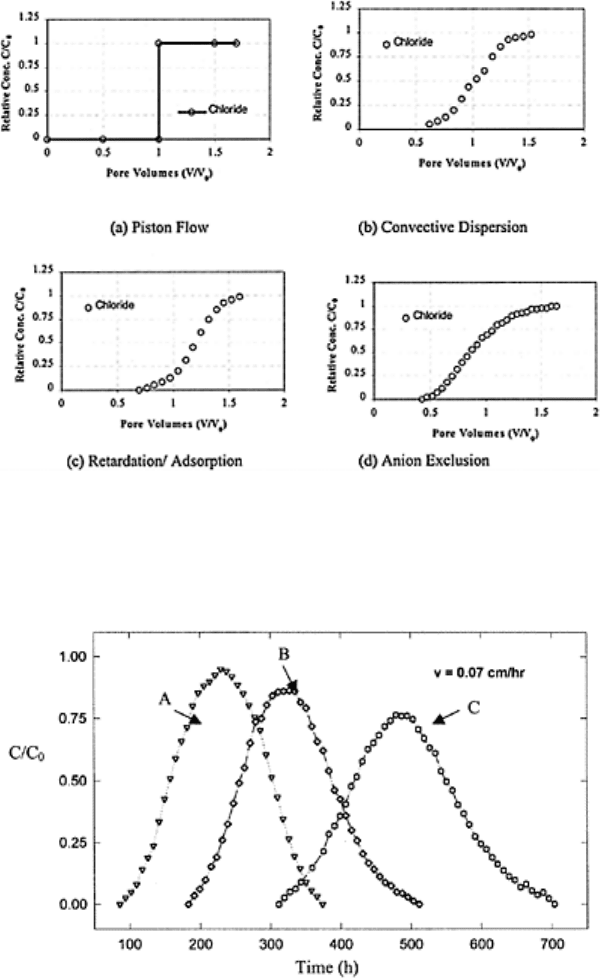
FIGURE 16.3 Interpretations from
experimental breakthrough curves.
(Modified from Kutilek and Nielsen,
1994; Shukla et al., 2002.)
FIGURE 16.4 The progressive
attenuation of BTCs for 10 cm (A), 20
Solute transport 445

cm (B), and 30 cm (C) soil columns
for a pulse type chloride application
through laboratory soil columns.
(Redrawn from Shukla et al., 2000.)
place. This attenuation is the direct result of dilution. Therefore, solute applied as a pulse
cannot carry its total mass beyond a certain depth. The total volumes of solution and total
time required to completely displace the applied pulse increases with displacement length
(Kutilek and Nielsen, 1994) (Fig. 16.4).
16.7 DISPERSION PROCESSES
Assuming the random capillary bundle concept (see Chapter 12), the classical dispersion
theory was developed and a dispersion equation was suggested, which is similar to Fick’s
law and takes into account both dispersive and diffusive fluxes (Taylor, 1953; De Josselin
De Jong, 1958; Bear and Bachmat, 1967; Fried and Combarnous, 1971). There are
several mechanisms that cause macroscopic mixing and are generally accounted for in the
dispersion coefficient. Some of them are mixing due to tortuosity, inaccessibility of pore
water, recirculation due to flow restrictions, macroscopic and hydrodynamic dispersion,
and turbulence in flow paths (Greenkorn, 1983). In addition, molecular diffusion, the
presence of dead-end pores, sorption, exclusion, and physical nonequilibrium affect the
degree of asymmetry in BTCs in different proportions (Nielsen et al., 1986).
The hydrodynamic dispersion coefficient (D) is proportional to the pore water velocity
of a solute under steady state flow conditions (Biggar and Nielsen, 1967; Bear, 1972).
(16.19)
D=λv
(16.20)
The proportionality constant, A,, in Eq. (16.20) is known as dispersivity. The value of
dispersivity depends upon the scale over which water flux and solute convection is
averaged. Dispersivity is also dependent on the moisture content of the porous media
(Krupp and Elrick, 1968) and decreases rapidly as moisture content decreases from
saturation. A 10-fold increase in longitudinal dispersivity is reported when moisture
content decreases from saturation (Wilson and Gelhar, 1974). Some typical values of
dispersivity for laboratory soil columns range from 0.5 to 2 cm (Jury et al., 1991), 0.11 to
0.37 cm (for loam soil) and 0.14 to 0.22 cm (for sandy loam soil; Shukla et al., 2003).
The dispersion processes are site specific and depend upon the subtler factors, which are
related to the experimental conditions (Flury et al., 1998). The longitudinal dispersivity
values are measured in field soils by placing a suction cup at different depths and
measuring solute breakthough as a function of time. The dispersivity calculated for field
soils by one-dimensional convective dispersion Eq. (16.23) or method of moments (Jury
and Roth, 1990) are given in Table 16.1.
Principles of soil physics 446

TABLE 16.1 Dispersivity Values Measured in
Field Soils Using Suction Cups
Soil Tracer Application rate,
cmd
−1
Dispersivity
cm
Reference
Clay, silty
clay
Cl, Tritium 2 9.4 Van de Pol et al. (1977)
Clay loam Cl, NO
3
– 8.3 Biggar and Nielsen (1976)
Clay loam Br 96 5.2–23 Fleming and Butters (1995)
Clay loam Br 30, 33, 41, 67 16–38 Jaynes (1991)
Loam Cl 9.6–19.2 29 Roth et al. (1991)
Loamy
sand
Br 1.1 3.2–15.8 Butters et al. (1989)
Loamy
sand
Cl, NO
3
,
BO
3
1.3 1–2 Ellsworth et al. (1996)
Sand Cl 84 0.7–1.6 Hamlen and
132 0.8–2 Kachanowski (1992)
Sand Cl 84, 117 17, 2.7 Van Wesenbeck and
Kachanowski (1991)
Source: Modified from Flury et al., 1998.
16.8 RELATIONS BETWEEN DISPERSION COEFFICIENT AND
PORE WATER VELOCITY
The effective dispersion coefficient generally varies with mean microscopic flow
velocity. Based upon the magnitude of the Peclet number (P, defined as vL/D, where L is
a characteristic length), within the range of average pore water velocities, molecular
diffusion dominates the dispersion of the solute at smaller displacement velocities and
gives way to convective dispersion at greater velocities. Hence, for relatively small
average pore water velocities we expect the apparent diffusion coefficient to have values
close to that of the diffusion coefficient (D
o
) in the soil solution, and to be only somewhat
dependent on pore water velocity. At relatively large velocities, the dispersion coefficient
is strongly related to pore water velocity.
The five dispersion regimes can be identified in Fig. 16.5 as (i) pure molecular
diffusion; (ii) molecular diffusion and kinematic dispersion; (iii) predominant kinematic
dispersion and (iv) and (v) as pure kinematic dispersion regimes (Shukla et al., 2002). In
regimes ii-v, an increase in average pore water velocity increases mixing and reduces the
impact of molecular diffusion in the direction of flow. Using mixing cell approximations,
it can be shown that in the region 0.01<P<50, dispersion is directly proportional to pore
water velocity (Perkins and Johnston, 1963). Further
Solute transport 447
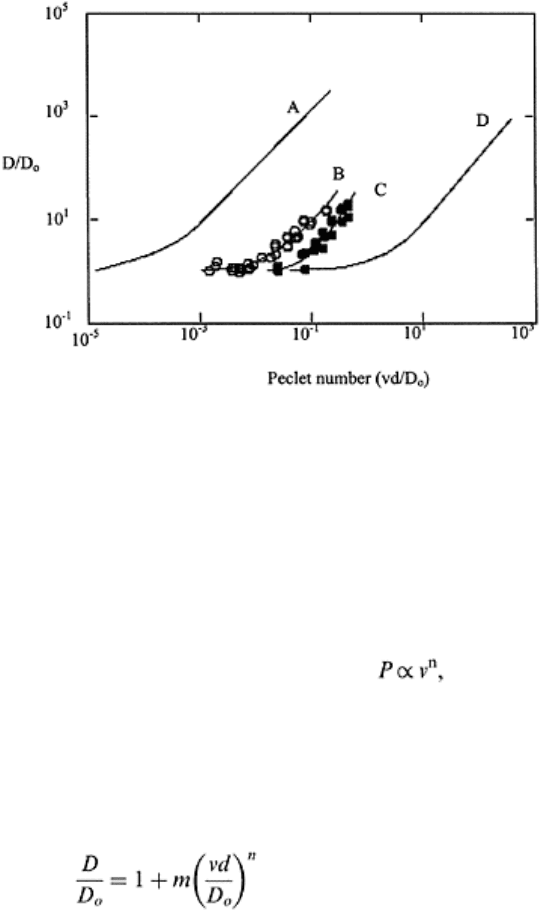
FIGURE 16.5 The relationship
between DD
0
−1
and Peclet number for:
(A) field soil (A) (from Biggar and
Nielsen, 1976), (B) loam, (C) sandy
loam (from Shukla et al., 2002), and
(D) single grain material (from
Pfannkuch, 1963). (Redrawn from
Shukla et al., 2002.)
increases in P results in a nonlinear relation to velocity ( with n>1). Pfannkuch
(1962) and Torelli and Scheidegger (1972) reported an n value of 1.2, Taylor (1953) of 2,
Biggar and Nielsen (1976) of 1.11, and Shukla et al. (2002) of 1.71 for sandy loam and
1.21 for loam.
The relations between D/D
o
and Peclet number (vd/D
o
) given as solid lines in Fig. 16.5
for natural undisturbed field soil by Biggar and Nielsen (1976), and for laboratory
columns of loam and sandy loam soils (Shukla et al., 2002) and for graded sands and
other single-grained materials (Pfannkuch, 1962) satisfy Eq. (16.21)
(16.21)
where
D
o
=0.66θ D
m
(16.22)
with D
m
being the diffusion coefficient for free solution. The D
0
in Eq. (16.22) can be
obtained from known values of θ and D
m
(see also Chapter 18). For loam and the sandy
Principles of soil physics 448
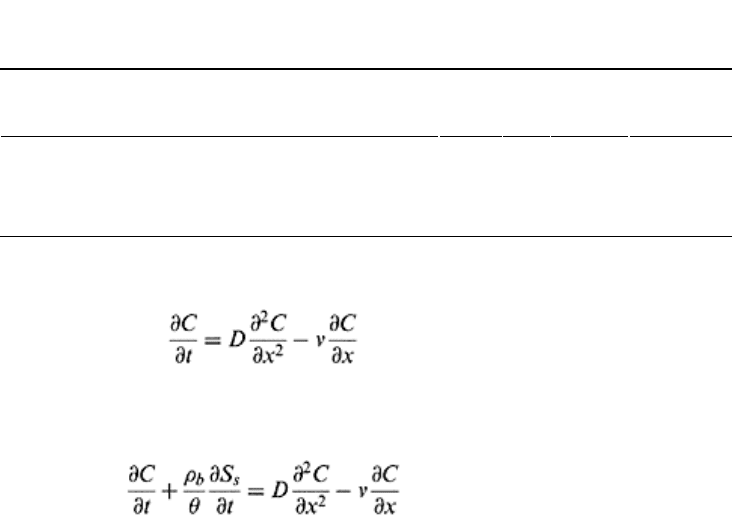
loam soils D
0
is 0.0222 and 0.0216 cm
2
h
−1
, respectively (Shukla et al., 2002). Other
reported values of D
0
in literature are: 0.02 cm2 h
−1
by Jury et al. (1991), 0.01 cm2 h
−1
by
Sposito (1989), and 0.0203 cm
2
h
−1
by Shukla et al. (2003). The values of m increase with
decreasing values of average particle diameter d while values of n range between 1 and 2
(Table 16.2). In the loam and sandy loam soils as well as the field soil, decreasing
average particle diameter (increasing clay content) is associated with soil structure. The
loam has relatively large pores as a result of microaggregates, and the sandy loam,
although containing less clay than the loam, nevertheless has large pores also associated
with its microaggregates as well as those associated with its high sand content. The field
soil manifests the greatest value of m because of its large pore size distribution owing to
its high clay content, its aggregation and its natural field structure.
16.9 MATHEMATICAL REPRESENTATION OF THE SOLUTE
TRANSPORT PROCESS
The simplest form of one dimensional convective-dispersive equation (CDE), assuming
macroscopic steady state water flow, constant soil– moisture content, and no interactions
between the chemical and the solid
TABLE 16.2 Parameters for Eq. (21) for the
Results Illustrated in Fig. 16.5
Soil m n d mm D
o
cm
2
h
−1
Laboratory columns (mostly sand) (Pfannkuch 1962) 0.5 1.2 0.156 0.022
Sandy loam (Shukla et al. 2001) 70.5 1.71 0.0508 0.0216
Loam (Shukla et al. 2001) 141 1.21 0.0158 0.0222
Field soil (more clay) (Biggar and Nielsen 1976) 17780 1.11 0.00272 0.0250
phase was developed by Lapidus and Amundson, (1952), which is similar to Eq. (16.17),
for R=1
(16.22)
One additional term is added to Eq. (16.23) when chemical adsorption is included.
Following is the one-dimensional solute transport equation describing transport through a
homogeneous medium during steady state flow with adsorption [same as Eq. (16.17)]
(16.24)
The solution of Eq. (16.24) depends upon the knowledge of the relationship between
adsorbed concentrations, S
s
, and the solution concentration, C. Adsorption or exchange
reactions perceived as instantaneous are described by equilibrium isotherms S
s
(C), which
Solute transport 449
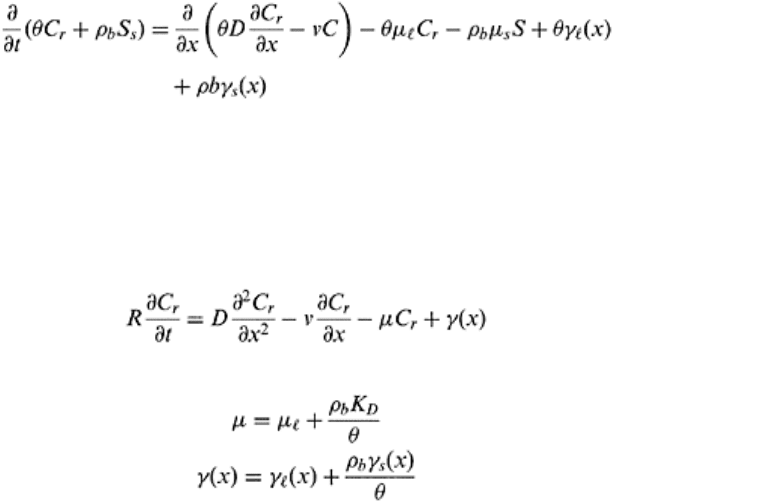
can be of the mass action, linear, Freundlich, Langmuir, or any other functional form
(Nielsen et al., 1986). Besides adsorption, the reactive process such as first-order
degradation and zero-order production can also be taken into account during miscible
displacement process. Therefore, the comprehensive CDE for one-dimensional transport
of reactive solutes, subject to adsorption, first-order degradation, and zero-order
production, in a homogeneous soil, is
written as:
(16.25)
where C
r
is the volume-averaged or resident concentration of liquid phase (ML
−3
), S
s
is
the concentration of the adsorbed phase (MM
−1
), v is the volumetric water flux density
(LT
−1
), µ
l
and µ
s
are first-order decay coefficients for degradation of the solute in the
liquid and adsorbed phases respectively (T
−1
), γ
1
(ML
−3
T
−1
), and γ
s
(MM
−1
T
−1
) are zero-
order production terms for the liquid and adsorbed phases, D, θ, ρ
b
, x, and t are the same
as defined above. Assuming reversible equilibrium adsorption [Eq. (16.16)] and steady
state flow in a homogeneous soil, Eq. (16.25) is modified to:
(16.26)
where µ and γ are combined first- and zero-order rate coefficients
(16.27)
(16.28)
16.10 SORPTION PHENOMENON
Adsorption is a process where ions or molecules are attached to the surfaces of soil
solids. This results in a higher concentration of solute at the surface of solid phase than in
the bulk solution. The opposite of adsorption is anion exclusion where concentration in a
soil solution is higher than the solid phase. Sorption and exclusion processes are
important in modifying the movement of chemicals through a soil domain. The plot
between amount adsorbed and the amount in solution is known as the adsorption
isotherm (Fig. 16.6). The forces active at soil-water interface and at molecular level are
electrical and are the same at both levels. These forces vary as the reciprocal of the
separation distance raised to a power. Equilibrium sorption (Fig. 16.6) of organic
molecules is dominated by the organic fraction of soil.
Principles of soil physics 450
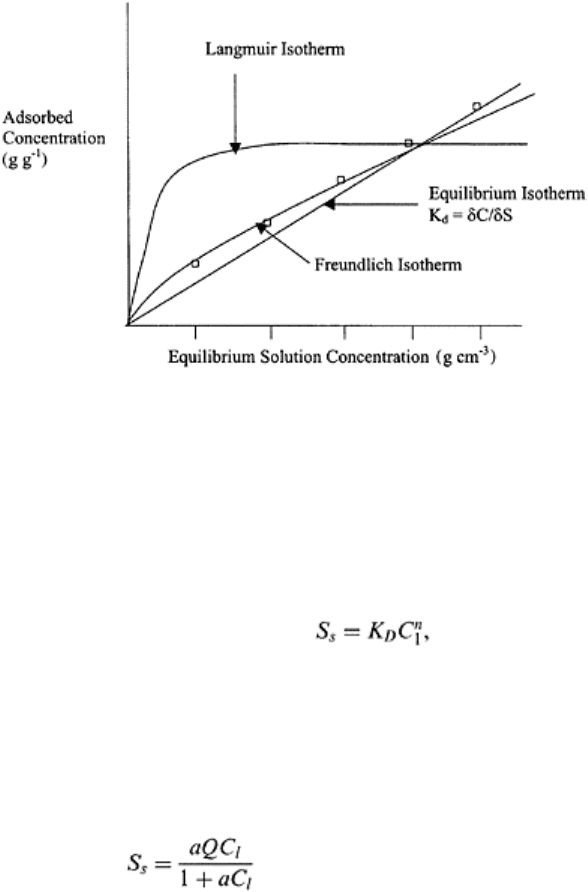
FIGURE 16.6 A schematic of
adsorption isotherms. (Modified from
July et al., 1994)
To account for this effect, value of K
D
[Eq. (16.15)] is divided by soil organic carbon
content (SOC) as below:
K
D
=SOC * foc
(16.29)
The Freundlich adsorption model is given as
where n is close to 1 (Fig.
16.6). The Freundlich model is based on the assumption that there is no limiting
concentration of adsorbate as solution concentration is increased without limit. This is
unrealistic because available surfaces in soil domain are limited for adsorption to occur.
The Langmuir adsorption model was developed from kinetics of gas adsorption on solid
surfaces and has a sound conceptual basis. The model assumes that the energy of
adsorption is constant and independent of surface coverage, the adsorbed molecules do
not interact with each other, and the maximum possible adsorption is that of a complete
monolayer (Fig. 16.6). The equilibrium adsorption (S
s
) by Langmuir model is as follows:
(16.30)
where a is the ratio of adsorption rate constant, Q is the total number of available
adsorption sites, and C
l
is the solute concentration in solution. Several sorption models
are available in literature, some are derived from the adsorption of gases by solids while
others are either empirical or kinetic.
Based upon multireaction approach, Selim (1992) proposed a model that involves
three types of sites during sorption. The first type of site is equilibrium (S
se
), where
equilibrium between the sorbed and solution phases is established quickly. The second
Solute transport 451
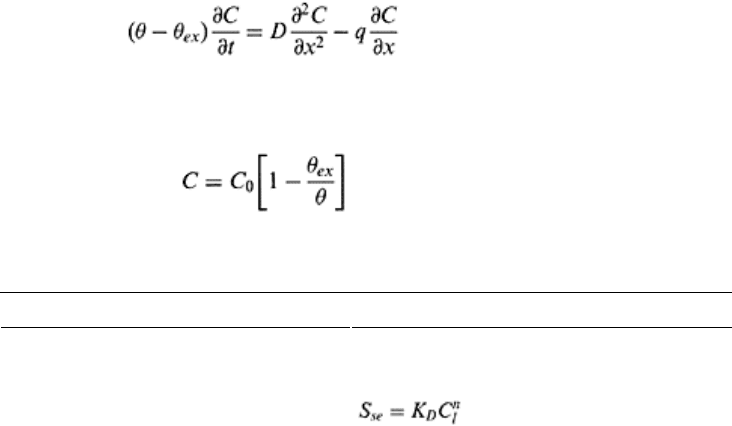
type of sites is kinetic, S
sk
, where adsorption is considered time dependent, and the third
type-site is subjected to irreversible retention S
sir
. Total amount of sorption can be
described by the following relationship
S
s
=S
se
+S
sk
+S
sir
(16.31)
Some of the equilibrium and kinetic sorption relationships are presented in Table 16.3.
16.11 EQUILIBRIUM ANION EXCLUSION MODEL
Certain anions interact with the negatively charged solid surfaces of the soil (such as clay
or ionizable organic matter) and are excluded from the liquid region adjacent to the soil
particle surfaces. This phenomenon is known as anion exclusion or negative adsorption.
Eq. (16.17) represents the anion exclusion phenomenon for R<1. In the presence of a soil
solution, the negative charge extends from the surfaces of particles into the solution and
forms diffuse double layer (Bolt, 1979). The existence of the negative charge causes
repulsion of anions from this region. The resulting concentration gradient reduces the
concentration of anion at the soil surface to zero, which increases exponentially with
distance and at the limit of diffuse double layer becomes equal to the concentration of
bulk solution (Bolt, 1979). Assuming that effective exclusion volume (θ
ex
) expressed as
volumetric moisture content is evenly distributed over the particle surface, the one-
dimensional transport of an anionic solute exhibiting anion exclusion can be described as
follows (Bresler, 1973; James and Rubin, 1986)
(16.32)
The observed concentration (C) is less than the concentration of bulk solution (C
0
)
because of the exclusion volume, which does not contain ions. This interrelationship
between C and C
0
can be expressed as follows:
(16.33)
TABLE 16.3 Equilibrium and Kinetic Models for
Sorption in Soils
a
Model Formulation
EQUILIBRIUM TYPE
Linear S
se
=K
D
C
l
Freundlich
General Freundlich S
s
/S
smax
=[ωC/(1+ωC)]β
Rothmund-Kornfeld ion exchange S
si
/S
sT
=K
D
(C
i
/C
T
)
n
Principles of soil physics 452
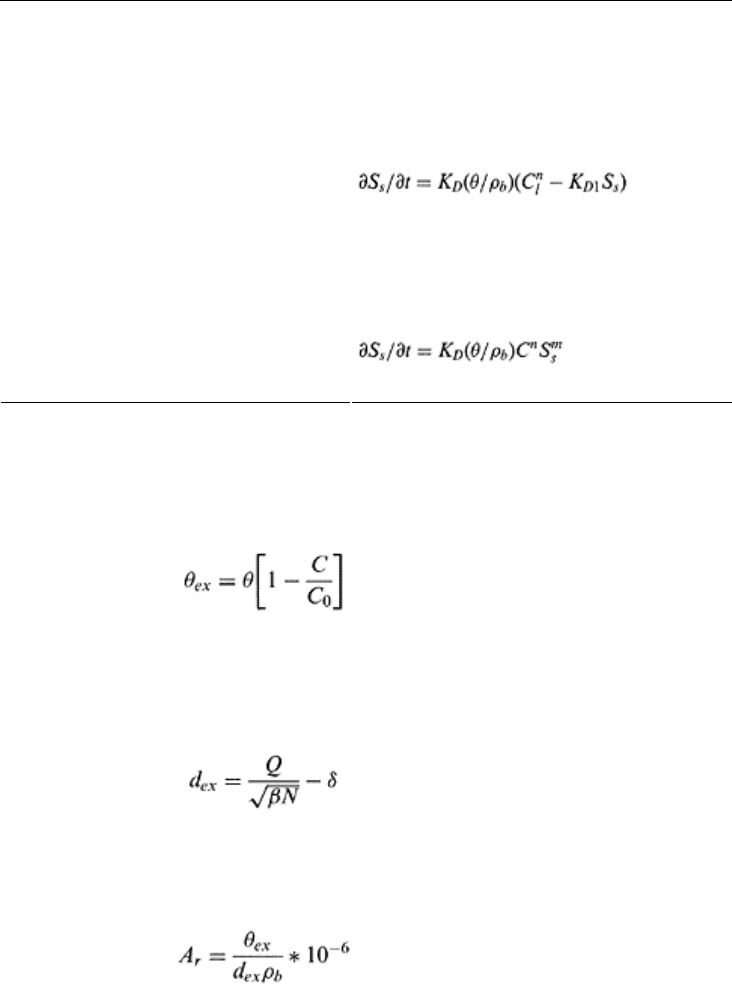
Langmuir S
s
/S
smax
=(ωC)
β
+ωC)
General Langmuir-Freundlich S
s
/S
smax
=(ωC)
β
/(1+ωC)
β
Langmuir with sigmoidicity S
s
/S
smax
=(ωC)/(1+ωC+ω/C)
KINETIC TYPE
First order ∂S
s
/∂t=K
D
(θ/ρb)(C
l
−KD
1
S
s
)
nth order
Irreversible (sink/source) ∂S
s
/∂t=K
D
(θ/ρ
b
)(C−C
p
)
Second-order irreversible ∂S
s
/dt=K
D
(θ/ρb)C(S
smax
−S
s
)
Langmuir kinetic ∂S
s
/∂t=KD(θ/ρb)C(S
smax
−S
s
)−K
D
S
s
Elovich ∂S
s
/∂t=A exp(−BS
s
)
Power
Mass transfer ∂S
s
/∂t=K
D
(θ/ρ
b
)(C−C*)
a
Where k, A, B, n m, S
s
, S
smax
, C*, C
p
, and ω are adjustable model parameters.
Source: Modified from Selim and Amacher, 1997.
If the sufficient volume of input solution (concentration=C
0
) infiltrates in a soil column
for a long duration, the excluded water content can be calculated by using Eq. (16.34)
(Bond et al., 1982)
(16.34)
The C in the soil profile is always lower than C
0
when anion exclusion is occurring. The
anion exclusion also increases the average velocity of travel of anions in the soil profile.
By excluding the anions from the diffuse double layer where water is either moving
slowly or is immobile, the rate of transport is greater than given by q/θ. Bolt (1979)
assumed anion exclusion to be evenly distributed over the soil surface of thickness d
ex
.
(16.35)
where β is a constant (1.06×10
19
mkeq
−1
at 25°C), N is the total normality of bulk
solution (keq m
−3
), Q is a factor for ionic composition of bulk solution (m
−1
), and δ a
correction term. The specific surface area (A
r
) can be calculated from exclusion volume
and bulk density (ρ
b
; Mg m
−3
) as follows
(16.36)
16.12 NONEQUILIBRIUM TRANSPORT
Solute transport 453
